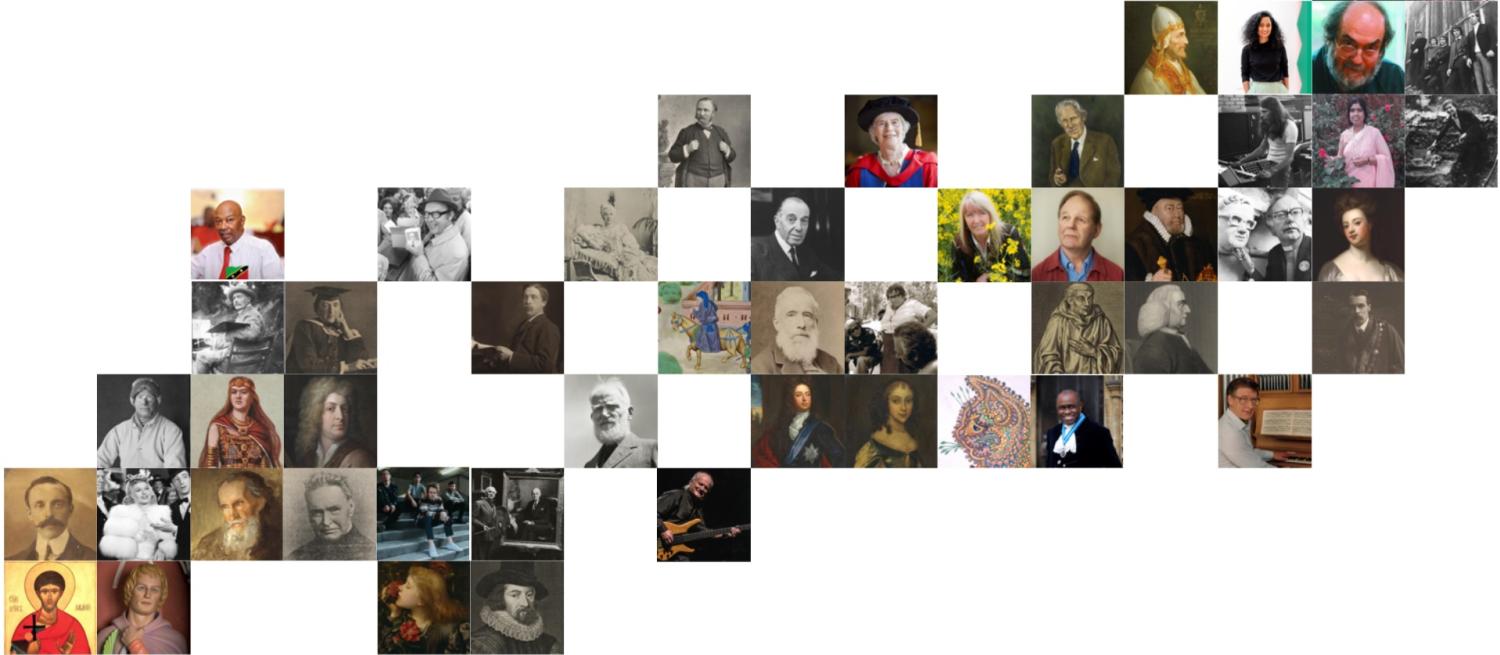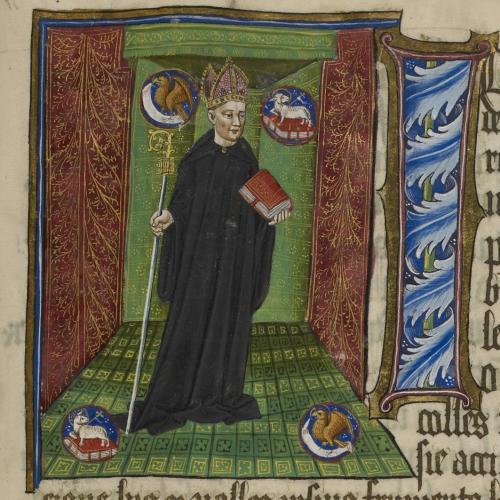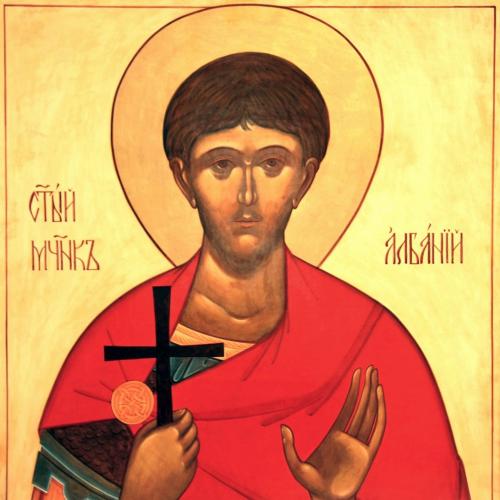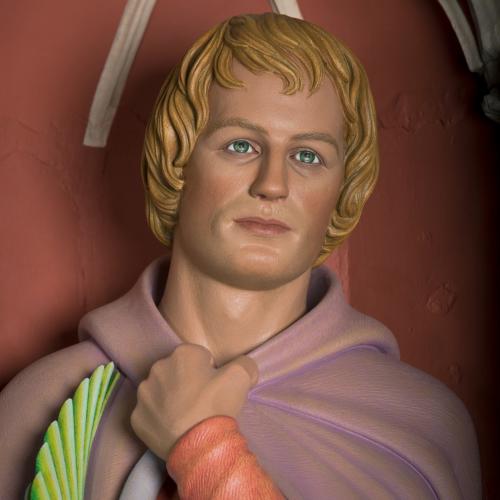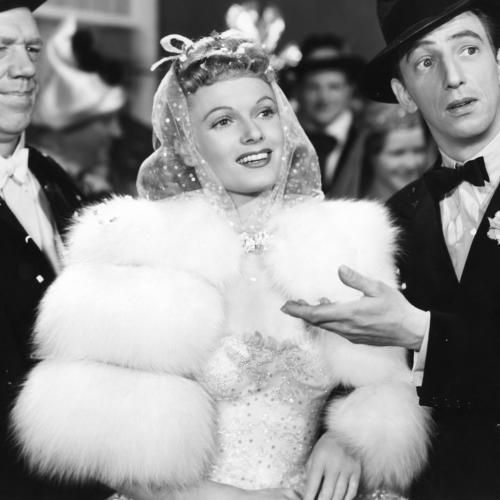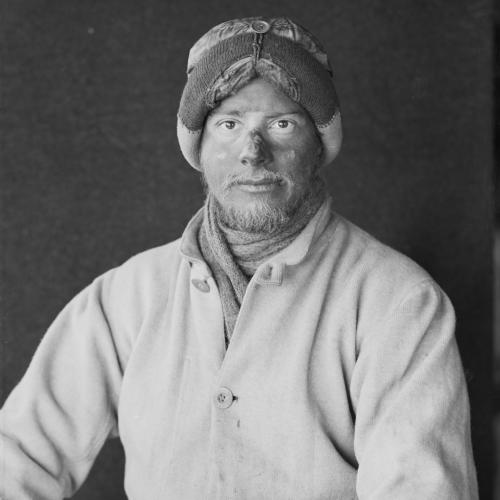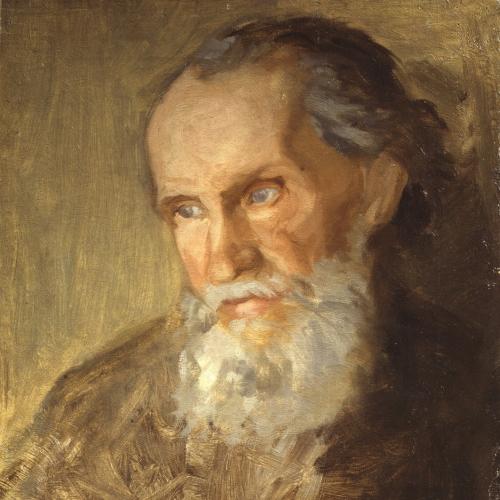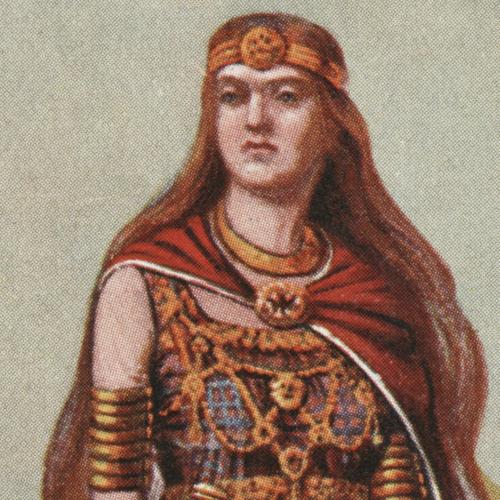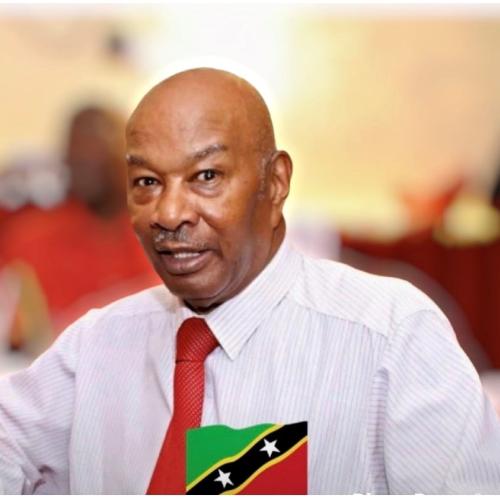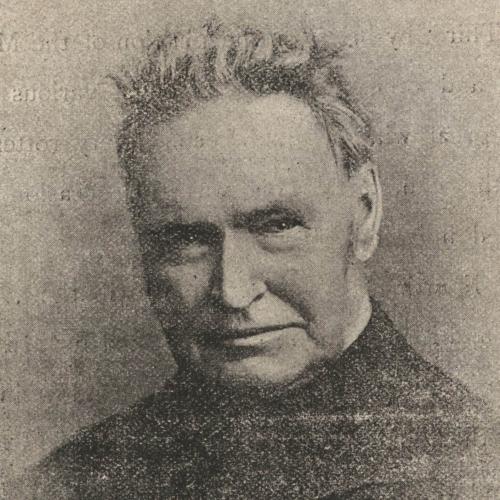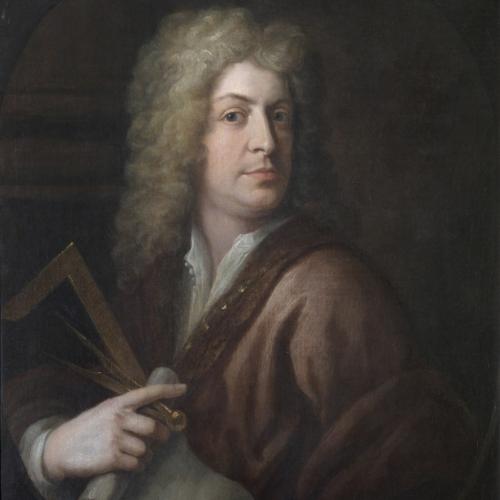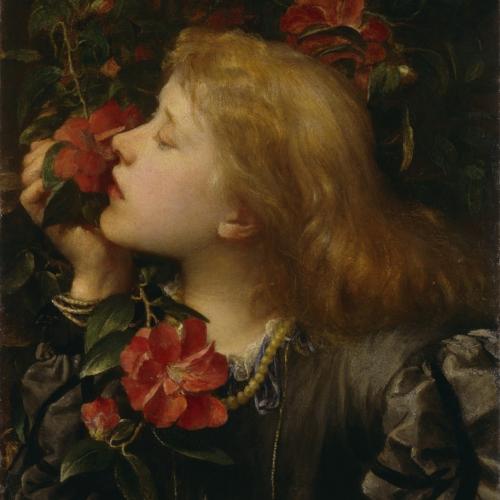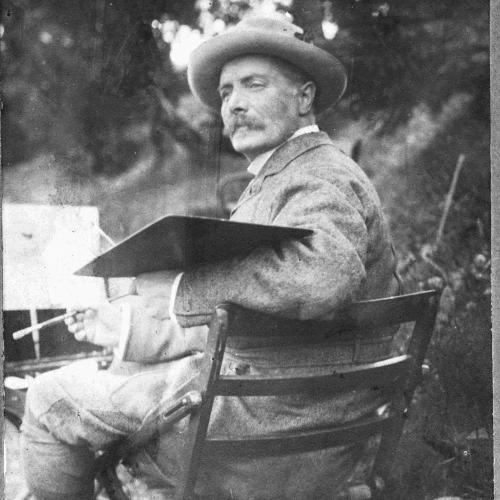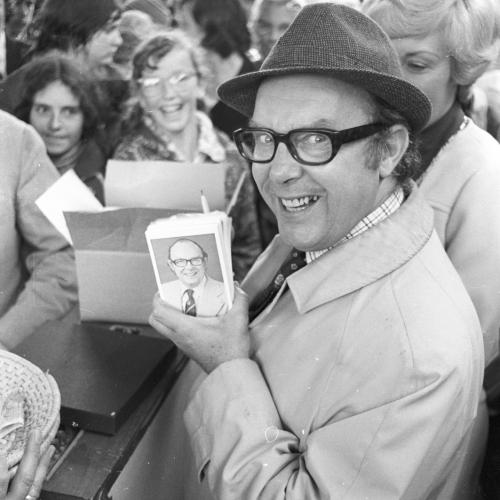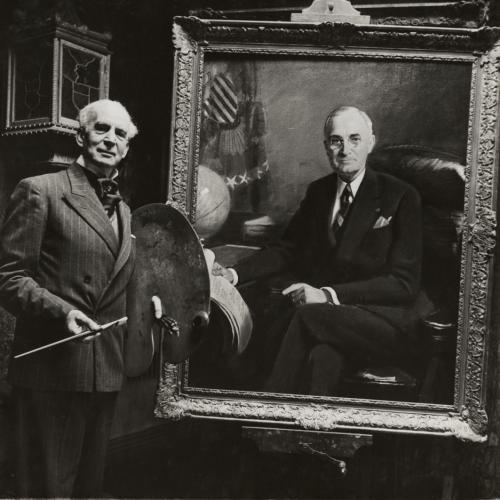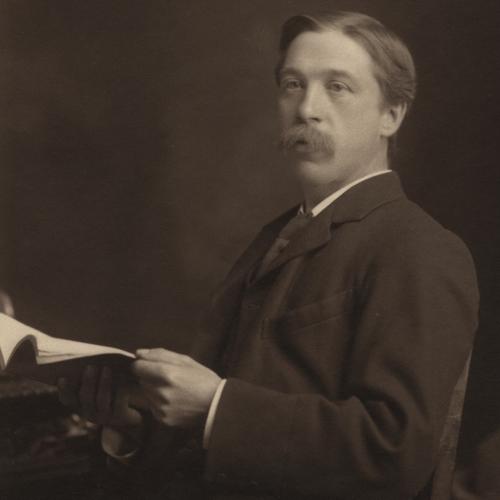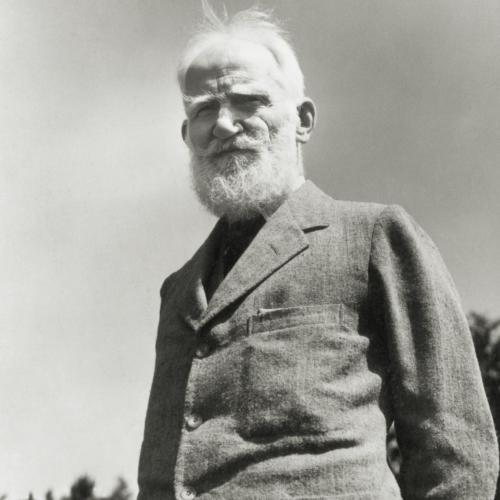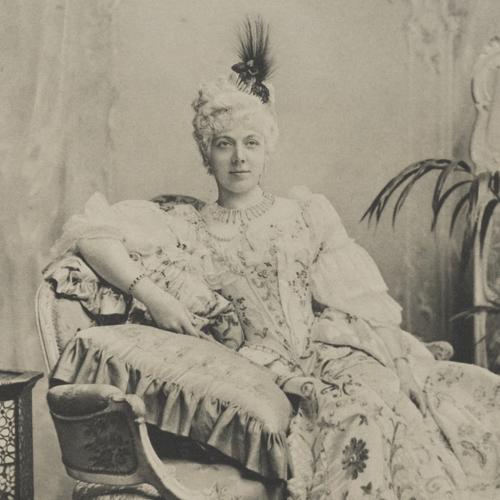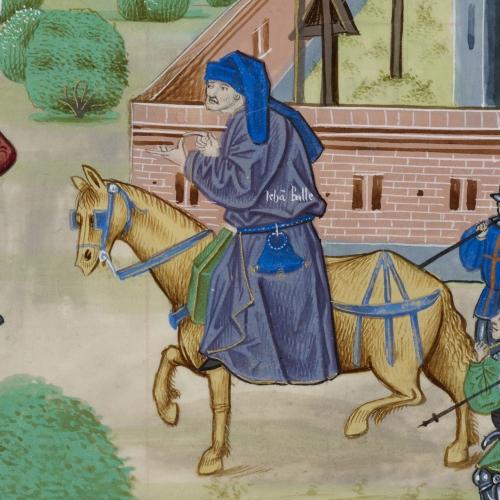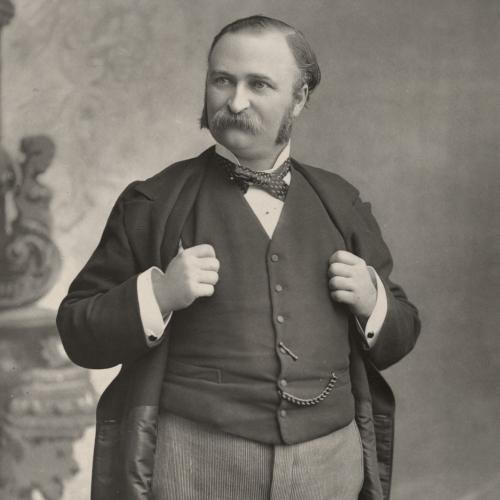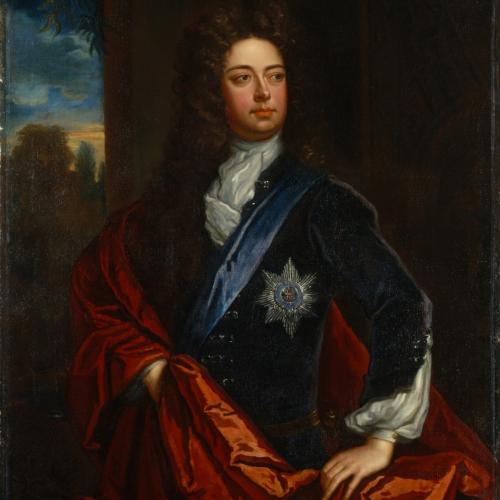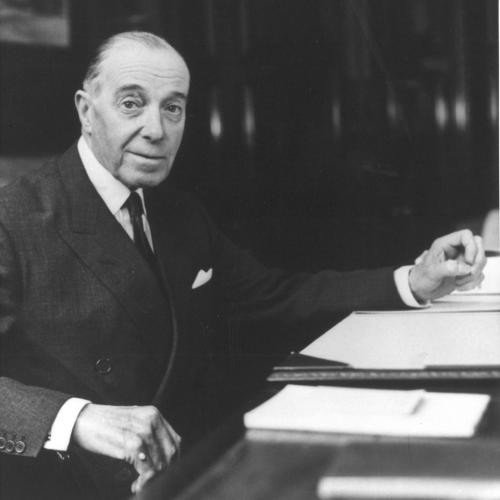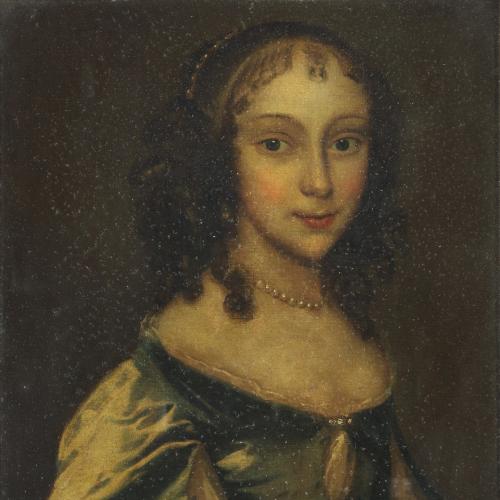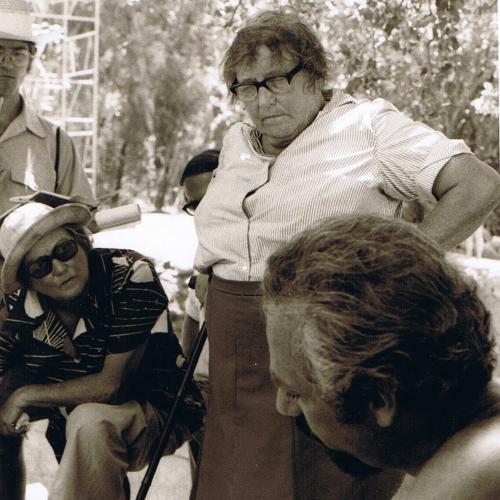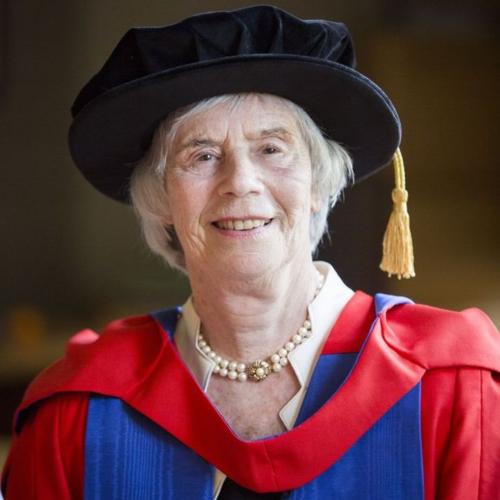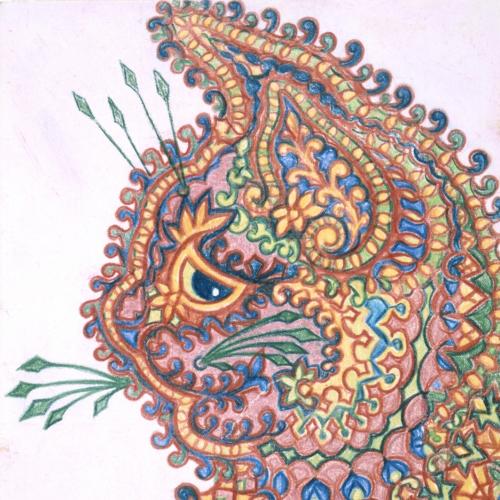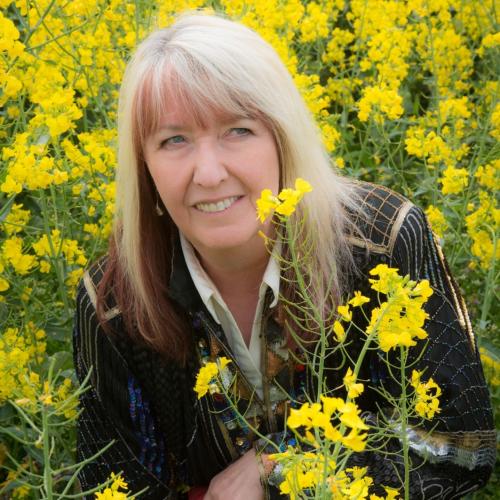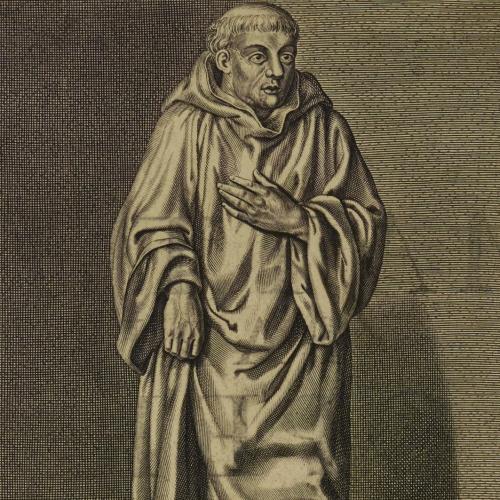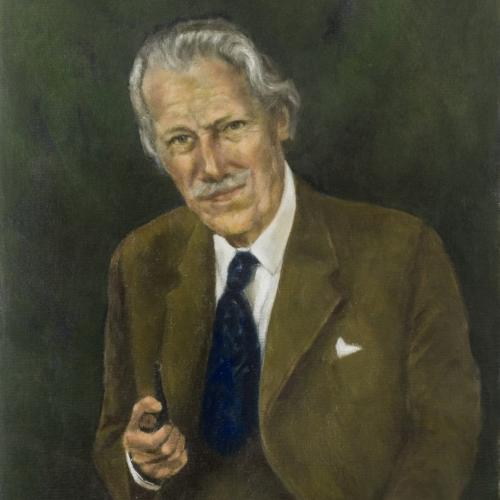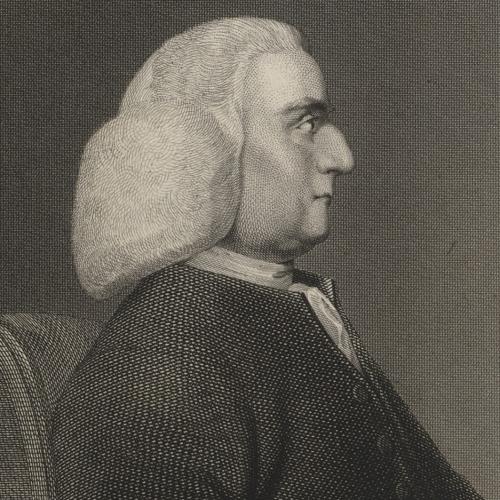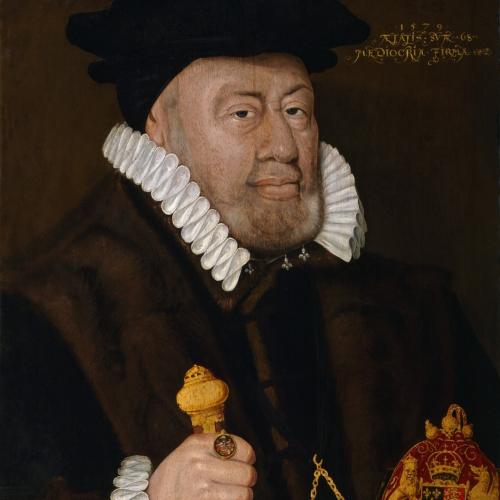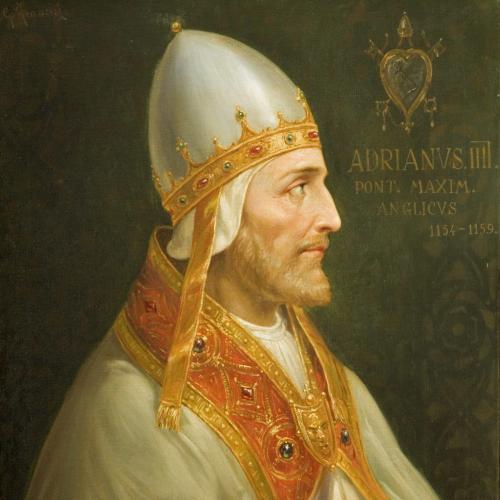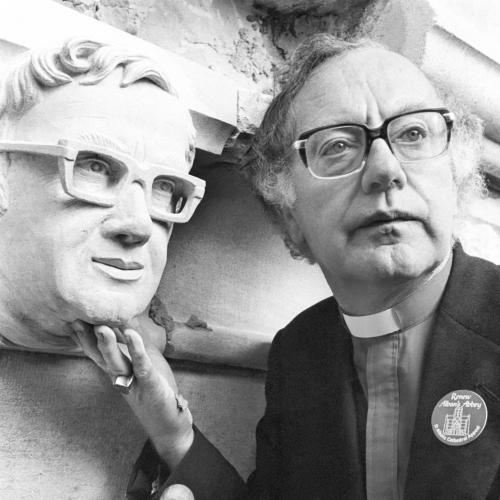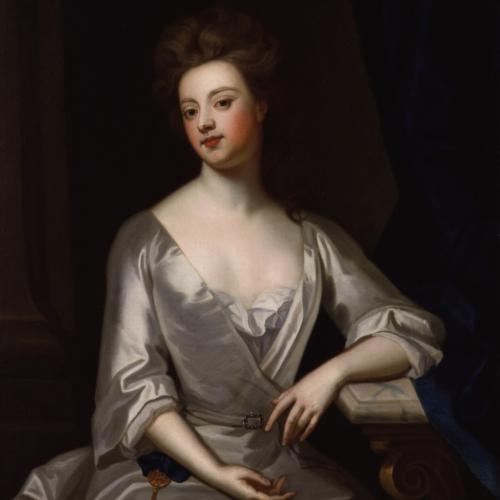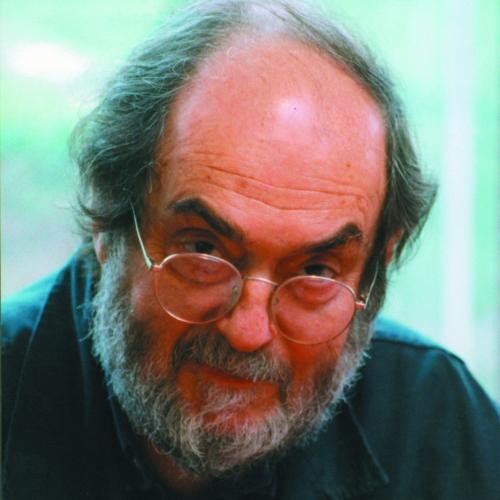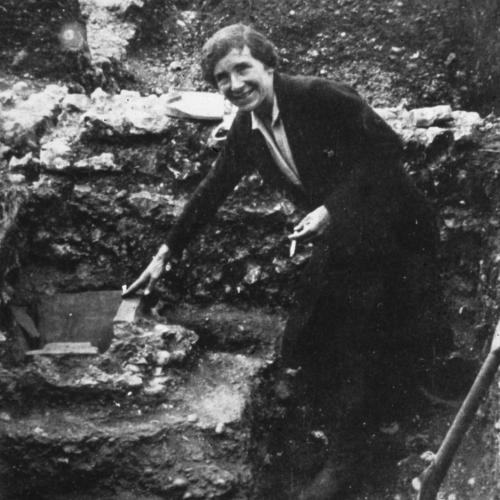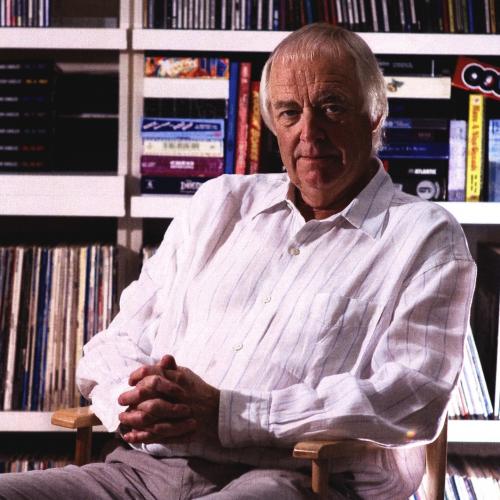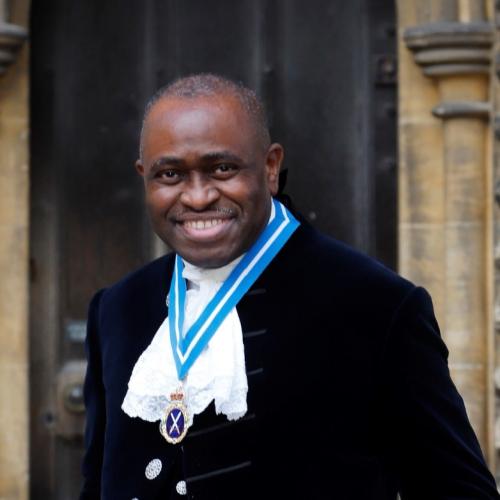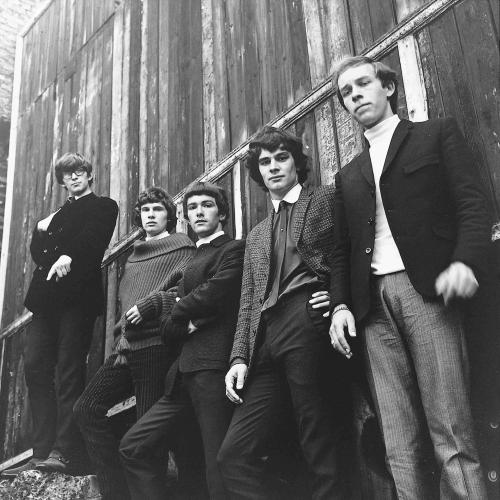On this page you can find short biographies of the people featured in our exhibition A portrait of St Albans. These are available on a touchscreen at the top of the stairs, on the landing for you to browse if you visit in person.
The biographies shown below are listed from the bottom left portrait to the top right.
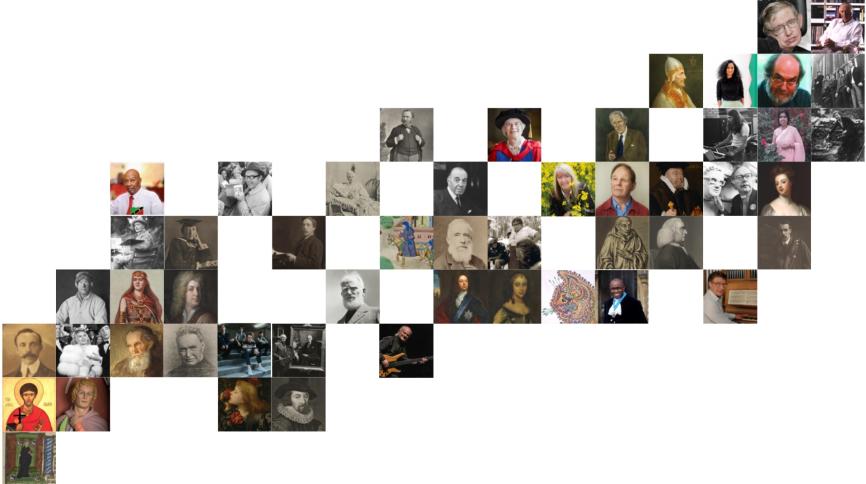
Abbot John of Wheathampstead
Abbot John, born circa 1390, was educated at St Albans Abbey School and Oxford.
In 1420 he was elected Abbot at St Albans. In 1440, pleading ill health he stepped down but was re-elected in 1451 till his death in 1465. He was renowned for his great learning, faith, love of music and literature, ability to increase the wealth of the monastery and for harsh discipline.
On a visit to Rome in 1423, he was granted 3 papal bulls (charters with lead seals) and it was these that enabled his remains to be identified during excavations at the Cathedral in 2018.
IMAGE: © The British Library Board. (Cotton Nero D. VII f.37)
Alban
Alban was a Roman British citizen who lived in the Roman town of Verulamium in the late 3rd century. He became the first British Christian martyr and saint.
Alban was converted to Christianity by a young Christian priest, while sheltering him from persecution. Alban was arrested and tried for treason, refusing to make a sacrifice to the Roman gods. He was taken to the hilltop outside the town and executed.
Alban’s grave became a place of pilgrimage and prayer. A church containing his shrine and a monastery were established. The Cathedral stands on or near the site of his execution.
Image: St Albans Cathedral
Arthur Melbourne Cooper
An early pioneer of film and photography, Arthur was born in St Albans in 1874, son of a photographer.
At 18 he worked with Birt Acres who was experimenting with moving pictures. He experimented with new camera techniques and stop motion animation, including an 1899 advert for Bryant and May.
He was a prolific film maker and in 1901 set up Alpha Cinematographic Films in Alma Road. The Alpha Picture Palace followed in 1908 – one of the first recognisable cinemas, now The Odyssey Cinema.
He was a poor businessman, landed in debt and died in obscurity in 1961.
Image Ati Mul and (the late) Tjitte De Vries
Amphibalus
Saint Amphibalus is thought to be the priest who converted Saint Alban to Christianity. What happened to him afterwards is unclear; one story is that he fled to Wales, was hunted down by people from Verulamium and was caught and put to death.
The site of his burial on Redbourn Heath was said to have been revealed in a dream to Robert Mercer, guided by Saint Alban himself. In around 1178 Abbot Simon, hearing of this, sent monks to excavate. Bones were found, and a small priory was established on the site. The shrine to Amphibalus now stands in St Albans Cathedral.
Image: St Albans Cathedral
Anna Neagle
Film actress Anna was born Marjorie Robertson in 1904. She wanted to become an actress from an early age, but her parents sent her to St Albans High School to broaden her ideas.
She enjoyed her time at the High School but continued in her ambition and joined the chorus of a West End show. She secured film roles and changed her name to Anna Neagle.
In the 1930s she met and later married film producer and director Herbert Wilcox. She had a very long successful career and was made a Dame in 1969. She died aged 81 in 1986.
Image: Wikipedia - RKO
Apsley Cherry Garrard
Born in 1886 at Lamer Park, Wheathampstead, he joined Scott’s 1910 Antarctic expedition as an assistant scientific officer, the youngest member of the group, and known as Cherry.
Scott set off in November 1911, whilst Cherry remained at Cape Evans. In March, he set out to prepare base camp for their return but was forced back early. Cherry was among those who found the men perished in their tent. He forever blamed himself for not staying longer in March and perhaps saving them.
In 1922 he wrote The Worst Journey in the World, a classic of polar exploration.He died in 1957 and is buried in Wheathampstead.
Image: Scott Polar Research Institute, University of Cambridge, with permission
Benjamin Waugh
Reverend Benjamin Waugh was a Congregationalist minister working in the slums of Victorian London. He commuted to his work from his house
in Hatfield Road.
He was appalled at the terrible suffering particularly of workhouse children. He founded a ‘Society for Temporary Relief in Poverty and Sickness’ and a day home for working mothers to leave their children.
He was a founder of the London Society for the Prevention of Cruelty to Children and became first director of the National Society for the Prevention of Cruelty to Children in 1889, of which Queen Victoria became patron.
Image: NPG 3909. Benjamin Waugh by Lady Edna Clarke Hall, oil on canvas, circa 1904 © National Portrait Gallery, London
Boudicca
According to the Roman writer Tacitus, Boudicca was a woman of noble birth and wife of the Celtic king of the Iceni tribe, Prasutagus. On his death, the terms of his will naming the emperor and his two daughters as his heirs, were ignored. Boudicca was beaten and her daughters raped.
While the Roman governor was away in Anglesey in c.60 AD, Boudicca gathered an army of Iceni and Trinovantes. They burned Camelodunum (Colchester) and Londinium (London) to the ground and then turned to Verulamium (St Albans), which they also destroyed by fire. Boudicca’s eventual fate or where she is buried are unknown.
Image: St Albans Museums
Cyril Roper
Edmund Beckett
Although Cyril Roper was a man of few words but his vital work raising awareness of Prostate Cancer encouraged other men to look after their health and led to him receiving a commemorative bronze plaque from Prostate Cancer UK that can be seen in the Marlborough Road Methodist Church today.
Cyril took part in many fundraising events such as the March for Men and organising a Gala for prostate cancer. It was Cyril’s wish to prevent other men going through the fight he had to. Cyril also helped support the research of prostate cancer at Mount Vernon hospital by giving blood at every opportunity he could.
(image: Roper family)
A very successful lawyer and QC, Edmund took the title of Lord Grimthorpe when he became a peer.
He was a well-known amateur horologist, responsible for the design of the mechanism for Big Ben.
Controversially he considered himself to be a great amateur architect and stepped in to complete the renovations of the Cathedral at his own expense when the building was in desperate need of repair in the 1870s. His rebuilding of the west front, roof and transept windows were considered by many out of character and unsympathetic, but saved the building from ruin.
Image: St Albans Museums
Edward Strong
A prominent 17th century master mason, Edward Strong worked under architect Sir Christopher Wren at St Paul’s Cathedral, being responsible for several areas including part of the nave and dome.
He lived in St Albans at New Barnes. In 1710 he built Romeland House on Romeland Hill, for Dutchman Frederick Vandemeulen. He probably also built Ivy House opposite St Peter’s Church.
He famously sued the Duke and Duchess of Marlborough for money they owed for the building of the main part of Blenheim Palace.
He is buried at St Peter’s Church and his memorial stone is displayed inside.
Image: Library and Museum of Freemasonry
Eleanor Ormerod
Eleanor Anne Ormerod, born 1828, developed a passion for studying insects in her twenties. Her rise to prominence as an entomologist started when she began to publish her very popular Notes on Injurious Insects, under her own name and at her own expense.
She became the (unpaid) Consulting Entomologist of the Royal Agricultural Society – unusual for a woman and a self-taught scientist. She invented various methods of destroying some of the most harmful pests, though her war on the house sparrow proved less than popular.
She lived at Torrington House on Holywell Hill from 1887 until her
death in 1901.
Image: St Albans Museums
Ellen Terry
Born into a family of actors, Ellen began performing as a child, acting in Shakespeare plays in London, and touring throughout the British provinces in her teens.
At 16 she married the 46-year-old artist George Frederic Watts, but they separated within a year. She soon returned to the stage but began a relationship with the architect Edward William Godwin and retired from the stage for six years when they moved to a house in Harpenden.
She resumed acting in 1874 and was acclaimed for her portrayal of roles in Shakespeare and other classics. Her
career lasted nearly seven decades.
Image: NPG 5048. Ellen Terry (‘Choosing') by George Frederic Watts, oil on strawboard mounted on Gatorfoam, 1864 © National Portrait Gallery, London
E.R. Hughes
Known as ‘The Last of the Pre-Raphaelites’, Hughes lived in in Romeland Cottages near St Albans Cathedral, and is buried in Fleetville Cemetery. A specialist in watercolours, Hughes’ work included ambitious paintings like "Night with her Train of Stars", beautiful drawings in red or black chalk and book illustrations.
The young Hughes worked in the studio of Holman Hunt, a Founder member of the Pre-Raphaelite Brotherhood. When Hunt’s eyesight failed, Hughes assisted him, and is credited with painting the third and final version of "The Light of the World”, in its time the most famous painting in the world.
Image: Watts Gallery Trust
Enter Shikari
Band members Rou Reynolds, Chris Batten, Rob Rolfe and Rory Clewlow grew up in St Albans, attending Verulam and Sandringham Schools. The band formed in 1999 under the name Hybryd, but was renamed Enter Shikari in 2003.
The band is named after Shikari, a boat belonging to Rou Reynolds’ uncle. Their debut album Take to the Skies was released in 2007, reaching number four in the Official UK Album Chart, followed by several top 20 charting album releases. Their musical style combines influences from rock, in particular punk, and electronic music genres. They have been nominated for
a number of awards.
Image: Jennifer McCord
Eric Morecambe
Eric, with his wife Joan and family, lived in Harpenden from the 1960s, often mentioning the town during his TV appearances, along with Luton Town Football Club, of which he was a supporter and director.
He was born John Eric Bartholomew in Morecambe, Lancashire. He rose to fame and fortune with his lifelong comedy partner, Ernie Wise. Morecambe and Wise made numerous TV shows for both BBC and ITV, including the 1977 Christmas special, estimated to have an audience of over 28 million.
In 1999, some years after his death from a heart attack, he was voted funniest person of the 20th century in an internet poll.
Image: St Albans Museums
Francis Bacon
Baron Verulam, First Viscount St Albans is often regarded as the founder of modern scientific enquiry; his most famous work is Novum Organum.
Son of Sir Nicholas Bacon, he inherited the family estate at Gorhambury. He was a lawyer, MP for St Albans, philosopher and essayist. Under James I, he became Lord Chancellor; the innocent scapegoat for the King and the notorious Duke of Buckingham, he was charged with corruption and barred from holding any office of state and died five years later.
He died as a result of a chill, caught testing the preservation of a chicken with ice. His statue is at St Michael’s Church, where he is said to be buried.
Image: St Albans Museums
Frank Salisbury
Born in Harpenden in 1874 of humble beginnings, he became a well-respected society artist both in Britain and in America, specialising in portraits of the great and good, as well as huge canvases of historical and ceremonial events.
He exhibited more than 70 paintings at The Royal Academy, illustrated books and worked in stained glass - his favourite medium. He was a Methodist and painted many religious themes, a fine example being his mural in St Nicholas Church, Harpenden. He created 34 stained glass windows, including the Christopher window at the west-end of the Highfield Oval Chapel.
Image: NPG Ax76083. Frank Salisbury by Unknown photographer, bromide print, late 1940s. © National Portrait Gallery, London
Frederick Kitton
Artist, wood-engraver and author, Kitton is best known for illustrating and editing the works of Charles Dickens. He moved to St Albans in 1883 and became well known locally for his sketches of Hertfordshire.
He was passionate about preserving old St Albans. When The Gables in Market Place was purchased by Boots the Chemist in 1899 with the intention of demolishing it, he set up a petition and successfully urged Boots to reconsider and preserve
its character.
He was honorary Curator of Pictures at the newly opened City Museum, procuring many fine books, manuscripts and watercolour collections.
Image: St Albans Museums
George Bernard Shaw
Bernard Shaw was a playwright, critic and political activist who moved to London from Dublin in 1876.
He became a respected theatre and music critic. He joined and wrote pamphlets for The Fabian Society. He often expressed controversial views about politics, society and religion through his plays but found popular, though not always critical, acclaim.
In 1906, he and his wife Charlotte bought Shaw’s Corner at Ayot St Lawrence, where he lived until he died aged 96. He was awarded the Nobel Prize for Literature in 1925 and an Academy Award for his screenplay of Pygmalion in 1938.
Image: © National Trust Images
Georgiana , Countess Spencer
Margaret Georgiana Poyntz secretly married John 1st Earl Spencer in 1755. She was described as most accomplished, being well read, versed in several languages and a skilled musician and composer. She was also fond of the gaming tables.
She managed the Marlborough Alms Houses in Hatfield Road, the legacy of her husband’s ancestor Sarah, Duchess of Marlborough, as well as supporting many charities - founding a Bluecoat School for boys in Fishpool Street and St Albans Female Friendly Society, providing sickness benefits and pensions for women over 60.
She planted the great cedar tree which stands in Sumpter Yard by St Albans Cathedral.
Image: NPG Ax41170. Georgiana Elizabeth (née Spencer-Churchill), Countess Howe when Lady Curzon as Maria Leszczynska by Lafayette; photogravure by Walker & Boutall, photogravure, 6 July 1897; published 1899. © National Portrait Gallery, London
Jim Rodford
Bass guitarist Jim Rodford was born in St Albans. During the late 1950s and early 1960s, he was a member of the Bluetones, the biggest band in St Albans.
He helped his younger cousin, Rod Argent, found the Zombies in 1964, although he did not play with them at the time. After the Zombies disbanded in 1969, he and Rod founded Argent together and he played with the band until it disbanded in 1976.
From 1978 to 1996 he played bass guitar with The Kinks, then in 2004 joined the reformed Zombies, remaining a member until his death in 2018.
Image: The Rodford family
John Ball
John Ball was one of the leaders of the 1381 Peasants’ Revolt in England.
He was a priest in York and then Colchester, but was excommunicated in 1366 for his ‘inflammatory’ sermons, advocating a classless society. He continued to preach in open spaces such as market places and was frequently arrested.
In 1381, he was rescued from Maidstone Prison by the Kentish rebels and went with them to Blackheath, where he preached that lords and high-ranking clergy should be killed. The rebellion soon collapsed and Ball was brought to St Albans where he was tried and hanged on 15 July 1381.
Image: © The British Library Board (Royal 18 E. I, f.165v)
John Blundell Maple
John Blundell Maple was a successful businessman, politician and philanthropist. He ran his father’s furniture business which became the largest furniture shop in the world.
He became MP for Dulwich in 1887. He bought the Childwickbury Estate, was a successful racehorse owner and breeder and was knighted in 1892. He built and equipped the Sisters Hospital in Union Lane, St Albans in memory of his two young daughters, donated money to rebuild University College Hospital, gave summer parties for children from London and St Albans and gave Clarence Park to the city in 1894.
He died in 1903.
Image: St Albans Museums
John Churchill
John Churchill was a page at the court of Charles II. Aged 17 he joined the Foot Guards in the Household Division of the British Army and by 27 had risen to the rank of colonel. He married Sarah Jennings, whose dowry included Holywell House in St Albans.
During the reign of Queen Anne, he won many decisive victories and was made Duke of Marlborough. After his victory at the Battle of Blenheim in 1704, the Marlboroughs were granted the manor of Woodstock and money to build Blenheim Palace, though Holywell House remained a favourite home.
He was later charged with embezzlement and went abroad. His fortunes were restored under George I.
Image: NPG 553. John Churchill, 1st Duke of Marlborough, after Sir Godfrey Kneller, Bt, oil on canvas, circa 1690. © National Portrait Gallery, London
John Bennett Lawes
Agricultural scientist John Bennett Lawes was born at Rothamsted Manor, Harpenden which he inherited age eight, when his father died. He studied at Eton College and Oxford University but did not graduate.
He set up his first laboratory in his bedroom. His pioneering investigations into the effects of fertilisers led to the start of the chemical fertiliser industry and agricultural science. His partnership with Joseph Henry Gilbert resulted in the setting up of the Rothamsted Experiments in 1856, which continue to this day as the longest-running agricultural experiments in the world.
He was a benevolent man and provided many amenities for his local community.
Image: St Albans Museums
HJ “Jim” Joel
HJ “Jim” Joel inherited the Childwickbury Estate in 1940 following the death of his father, Jack Barnato Joel, who had bought the estate in 1906 from the Maple family after the death of its founder Sir John Blundell Maple.
Both father and son were successful racehorse owners and breeders, winning every Classic including the Derby on
three occasions. Jim Joel also won the Grand National in 1987.
Shortly before he died in 1992, Jim established a charitable foundation, The Childwick Trust, and on his death, the Trust was the principal beneficiary of his personal estate. In the years since his death, the Trust has distributed almost £70 million to local and national charities.
Image: Childwick Trust
Katherine Ferrars
Lady Katherine Ferrars, the ‘Wicked Lady’ of legend, was born into a wealthy family. Her parents died when she was young and she was made a ward of the Fanshawe family.
She was married at 14, to 16 year old Thomas Fanshawe, who gained control of her estates. After this, facts about her life are hard to come by, but according to legend, Thomas was away fighting for King Charles during the English Civil War and she was bored and poor so took to highway robbery.
Her ghost is said to haunt Nomansland Common where her loot is buried beneath a tree.
Image: Valence House Museum
Kathleen Kenyon
Archaeologist Dame Kathleen Kenyon graduated from Somerville College Oxford in 1929 with a degree in history. At the suggestion of the college librarian she took up archaeology, spending time at excavations in Zimbabwe as a photographer.
Returning to England, she worked under the direction of Mortimer and Tessa Wheeler at Verulamium, every summer between 1930 and 1935, entrusted with the oversight of the excavations of the Roman Theatre.
Her work on excavations at Jericho in the 1950s made her world-famous as a specialist in Neolithic cultures and for pioneering new archaeological techniques. She was made a Dame in 1973.
Image: Vassilios Tzaferis
Kitty Hart-Moxon
Kitty was born in Bielsko, Poland in 1926. Age 12 she fled with her family after the Nazi invasion and spent three years in hiding. In 1943 she was captured and taken with her mother to Auschwitz and later to Bergen-Belsen where she spent three years in forced labour, experiencing unspeakable horrors.
After liberation in 1945, she and her mother came to England in 1946. She feels compelled to speak out about her past and the consequences of intolerance, racism and hatred through giving lectures and appearing on radio and television. She has written two books.
Image: Kitty Hart-Moxon
Louis Wain
English artist Louis Wain (1860 – 1939) became famous for his paintings of cats.
By 1914, the market for his paintings declined and he suffered a series of misfortunes and financial difficulties. He was declared ‘insane’ in 1923 and was later diagnosed with schizophrenia. He was moved to Napsbury in 1930, aged 70, where he spent the last years of his life as a patient at the Middlesex County Asylum. He continued to draw and paint his highly colourful cats.
Interest in his work revived in the 1960s and it is now very collectable.St Albans Museums hold two of his paintings.
Image: St Albans Museums, original painting purchased with support from Hertfordshire Heritage Fund
Maddy Prior
Singer Maddy Prior was born in Blackpool but moved to St Albans in her teens, where she attended St Albans Girls School.
She met singer and guitarist Tim Hart and they began to sing together at folk clubs, releasing two albums. In 1969, they joined a new group called Steeleye Span. Their folk-rock style brought fame and many hit records such as
All Around My Hat.
Maddy left Steeleye Span in 1997 and began a successful solo career, returning to the group in 2002. Since 2003, she has run an artists’ retreat in Cumbria, which offers a variety of courses in performance.
Image: Peter Silver
Matthew Paris
A Benedictine monk based at St Albans Abbey, Matthew Paris was a historian, an artist in illuminated manuscripts and cartographer.
He joined the Abbey in 1217 and became their official recorder of events. His Chronica Majora is an important, though sometimes biased, historical source for the period 1235 to 1279, when the Abbey was visited by kings and others of great importance.
He travelled abroad on missions for the Pope and drew detailed maps and chronicled the deeds of Abbots. His paintings and illustrations include the execution of Alban and an elephant which had been given to Henry III.
Image: Hertfordshire County Council
Michael Morpurgo
Writer Michael Morpurgo was born in St Albans. He is best known for his books for children such as War Horse, which has been adapted both for the stage and for the screen.
After 10 years as a primary teacher, he and his wife established the charity Farms for City Children, with the aim of providing inner-city children with an experience of the countryside. With poet Ted Hughes, he instigated the role of Children’s Laureate and was himself the third to hold the post from 2003 to 2005.
He was knighted for his services to literature and charity in 2018.
Image: Harper Collins
Mortimer Wheeler
Sir Mortimer Wheeler was responsible for the major archaeological digs in Verulamium in the 1930s.
He studied Classics at University College London, then began his career in archaeology, specialising in the Romano-British period. He served as an officer during the First World War and was awarded the Military Cross.
He argued that archaeology required a scientific methodology and developed the ‘Wheeler Method’. He established The Institute of Archaeology in 1934. He oversaw numerous projects overseas and appeared on radio and television as well as lecturing. He is recognised as one of the most important British archaeologists of the 20th century.
Image: St Albans Museums
Nathaniel Cotton
Physician Dr Nathaniel Cotton studied medicine at Leiden University in the Netherlands, graduating in 1729. He worked at a private mental health hospital in Dunstable before moving to St Albans.
He set up his own hospital in a house on the corner of Dagnall Street and College Street, the ‘Collegium Insanorum’. His approach to treatment was enlightened for the times, recommending fresh air and a good diet for the treatment of depression, considering drugs to be useless.
Among his wealthy patients was the renowned poet William Cowper. Cotton married twice and is buried with his wives Ann and Hannah at St Peter’s Church in St Albans.
Image: NPG D20854. Nathaniel Cotton by William Henry Worthington; after John Thurston, stipple engraving published 1820 © National Portrait Gallery, London
Nicholas Bacon
Sir Nicholas was Lord Keeper of the Great Seal of England during the reign of Elizabeth I.
He qualified as a lawyer in 1533 and was married twice. He went to Gorhambury in 1561 and rebuilt the house, the ruins of which can be seen today.
The Queen visited him several times, the first of which resulted in the building of an extension, after the Queen commented on its small size.On another occasion, he persuaded her to grant two wine licences, the income from which contributed towards the costs of the school he had helped to found in the Lady Chapel.
Image: NPG 164. Sir Nicholas Bacon by unknown artist, oil on panel, inscribed 1579 © National Portrait Gallery, London
Nicholas Breakspear
As Pope Adrian IV, Breakspear was the only Englishman ever to hold the office, from 1154 to 1159.
He was born in Abbots Langley and educated at the Abbey School in St Albans. His father Robert served as a lay monk. Nicholas was refused admission to the monastery – told that his learning was not yet good enough.
He went to France to a monastery near Arles and rose to become an abbot. He was created Cardinal Bishop of Albano, then spent 2 years as papal legate (representative of the Pope) in Norway before returning to Rome. On the death of Pope Anastasius, he was elected Pope.
Image:Hertfordshire County Council
Peter Hurford
Born in 1930, organist Peter Hurford was Master of the Music at St Albans Cathedral for 21 years, retiring in 1978 and leading the Choir to be one of the best in the UK.
In 1963 he founded the International Organ Festival and was its Artistic Director until 1978, then becoming its President.
Working as a freelance organist, he became particularly well known for his interpretation of Bach’s organ music. At the 1997 Edinburgh Festival he played 15 concerts of Bach’s Organ Works and has made numerous recordings during his career.
Image: The Hurford family
Rana Begum
Now living and working as an artist in London, Rana Begum grew up in St Albans where she moved to with her family from Bangladesh at the age of 8. Rana went to school at St Albans Girls School and as a young artist studied her foundation course at University of Hertfordshire, which she has said had a pivotal impact on her in opening up ideas and disciplines.
Rana’s work is an ongoing investigation into the interaction between form, colour, and light. Her hallmark abstract works play with the ability to transform as the viewer moves around them.
Robert Runcie
Brought up on Merseyside, he went on to Oxford University. Interrupted by the Second World War, he became an officer in the Scots Guards, winning the Military Cross. He resumed his studies and was ordained in 1951.
After holding a number of posts, he became Bishop of St Albans in 1970, then in 1980, Archbishop of Canterbury. His liberal views and his belief in ecumenism (promoting unity between the world’s Christian Churches) were not always popular. However, his humour and intelligence made him a generally well liked figure.
On retirement in 1990, he returned to his home in St Albans where he died in 2000 and is buried in the Cathedral churchyard.
Image: St Albans Museums
Rod Argent
Rod Argent was the founder and keyboardist of English rock band The Zombies in 1961. He formed the band Argent after The Zombies broke up.
Rod was born in St Albans and was a chorister in the Cathedral Choir and a pupil at St Albans School where he met Zombies’ vocalist Colin Blunstone.
He founded Argent in 1969 with his cousin Jim Rodford (also born and brought up in St Albans) and had great success until they disbanded in 1976.
Image: St Albans Museums
Samuel Ryder
Samuel Ryder invented the concept of selling garden seeds in penny packets and built a very successful business around it.
He was a keen philanthropist and contributed to the civic life of St Albans, including being Mayor in 1905.
At the age of 50, he took up golf and from 1923 to 1925, together with his brother James, sponsored a number of golf tournaments and matches, mostly at his home club of Verulam. He was responsible for inaugurating the Ryder Cup competition. The first official event took place in 1927 for which Ryder donated the gold trophy.
Image: St Albans Museums
Sarah Churchill
Sarah Churchill was born Sarah Jennings in St Albans in 1660. She went to Court aged 13, where she met John Churchill. She became a close friend and confidante of Princess Anne, who later became Queen, which then made her the most powerful woman in England.
Sarah’s husband’s success in battles led to the titles of Duke and Duchess of Marlborough and the building of Blenheim Palace.
Sarah was a great business woman and became extremely wealthy. She wielded political influence at Court and in
St Albans where she maintained her favourite home, Holywell House. She also built the Marlborough Almshouses
on Hatfield Road.
Image: NPG 3634. Sarah Churchill (née Jenyns (Jennings)), Duchess of Marlborough, after Sir Godfrey Kneller, oil on canvas, circa 1702, based on a work of circa 1702 © National Portrait Gallery, London
Stanley Kubrick
Film director Stanley Kubrick was born in New York in 1928. He developed a passion for photography and film in his teens.
He made his first big Hollywood film in 1956 (The Killing) but disliked Hollywood and moved to the UK in 1961. He set up home at Childwickbury which became his main workplace as well as
his home.
He went on to make all his films in the UK, from Lolita in 1962, 2001: A Space Odyssey in 1968, A Clockwork Orange in 1972 and many more until his final film, Eyes Wide Shut, completed in
1999 shortly before his death.
Image: Christiane Kubrick
Stephen Hawking
Stephen Hawking was a pupil at St Albans School, from where he gained a scholarship to Oxford University. He achieved a first class degree and went to Cambridge University to begin a PhD in Cosmology. He was diagnosed with motor neurone disease aged 21 and given two years to live.
His research has led to new understanding of the origins of the universe, black holes and the Big Bang Theory. His book
A Brief History of Time stayed on the Sunday Times best seller list for 237 weeks.
He retired as Lucasian Professor of Mathematics in 1999, but continued his research at Cambridge until his death
in 2018.
Image: Rogelio A. Galaviz C. https://www.flickr.com/photos/29344843@N00/1338054683/
Syeda Momotaz Rahim
Community activist Syeda Momotaz Rahim was the first British Bangladeshi councillor in St Albans. She is particularly interested in fundraising for and engagement work with disaffected young people and communities.
As Housing and Communities Officer for St Albans District Council, she set up the First Family Housing and Health Group to reduce health and housing inequalities in St Albans. She founded and is director of the Hertfordshire Asian Women’s Association and founded The Tiffin Club in 2008, winning the East of England Regional Equality Award. She is also founder and director of Hertfordshire All Women’s Trust, specialising in gender equality work.
Image: Syeda Momotaz Rahim
Tessa Wheeler
Tessa Verney was born in 1893. She studied history at University College London where she met her husband, Mortimer Wheeler. She worked with him on a number of sites around the country.
During 1930 – 1934 they excavated at Verulamium, developing new techniques of excavation: ‘The Wheeler Method’. Tessa became an expert in lifting mosaics, she encouraged people to visit the site, trained students and gave lectures to local societies.
She was keen that a museum was set up to house the Verulamium finds. Sadly she died in 1936 before Verulamium Museum opened in 1939 to showcase their work.
Image: St Albans Museums
Tim Rice
Lyricist Sir Tim Rice attended Aldwickbury and St Albans Schools. Leaving Lancing School with A levels, he joined a law firm in London intending to become a solicitor. However, his first love was music and he joined EMI Records and later The Norrie Paramor Organisation.
He met Andrew Lloyd-Webber in 1965 and in 1968 they wrote Joseph and The Amazing Technicolour Dreamcoat to great acclaim. Jesus Christ Superstar and Evita followed.
Tim has collaborated with many others including Elton John (The Lion King) and Bjorn Ulvaeus and Benny Andersson (Chess). He was knighted for services to music in 1994.
Image: Tim Rice
Lionel Wallace
Lionel Wallace DL was appointed as the High Sheriff of Hertfordshire in 2020. He was born and brought up in Hertfordshire and was a student at Beaumont School St Albans.
Lionel is an Aeronautical Engineer and he has also been involved in Youth Work, through various organisations for over 40 years. This includes his role as Chair of Pioneer Youth Club, Chair of Hertfordshire Association for Young People, Church Organisations, The Prince's Trust and UK Youth.
His parents migrated from the Commonwealth Caribbean Islands of St. Kitts and Nevis in the 1950’s. Lionel is the first black High Sheriff of Hertfordshire.
The Zombies
Band members Chris White, Hugh Grundy, Colin Blunstone, Rod Argent and Paul Arnold met for the first time as The Zombies outside the Blacksmiths Arms pub in St Albans before their very first rehearsal. As a young band they played venues in the city including the Pioneer Club, Old Albanian and Old Verulamian rugby clubs, Ballito, Market Hall and here in the Town Hall.
The band were part of the 1960’s “British Invasion” with hits “She’s Not There” and “Tell Her No” and found worldwide chart-topping success with their hit single, “Time of the Season” in 1968.
